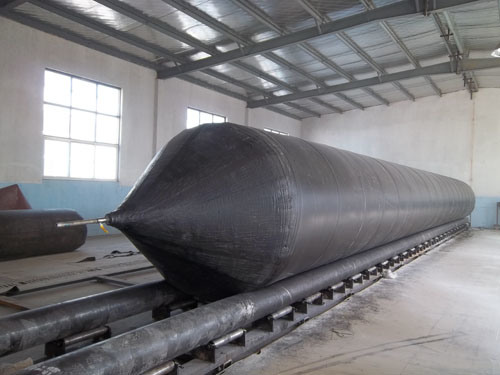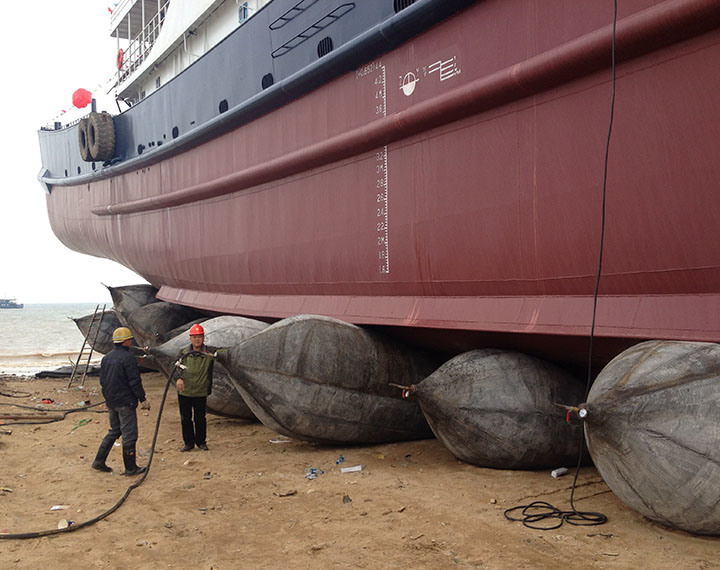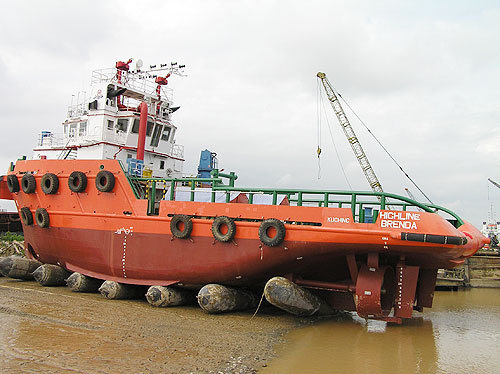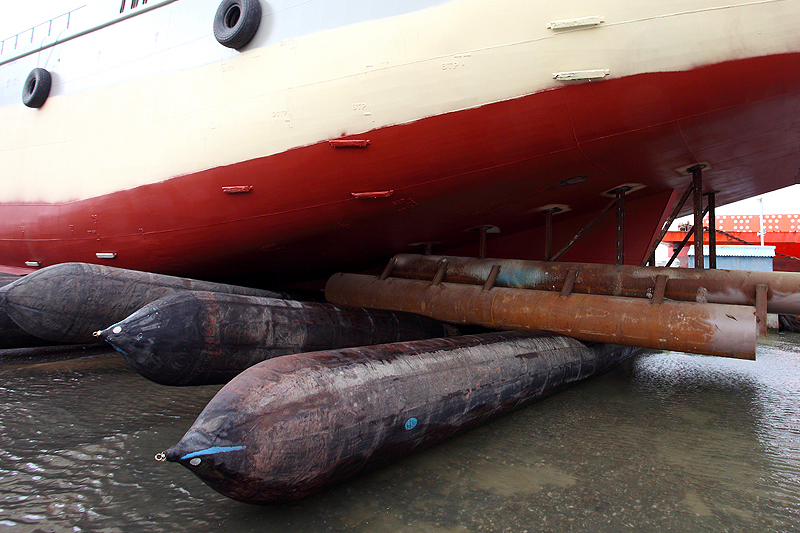Ship launching airbags are to be constructed of a cylindrical body and two conical heads (one at each end). Ship launching airbags with lots of advantages, such as easy to operate, time saving, saving investment safety, etc.


Major Strengths of Ship Launching Airbags:
High level of safety: Equipped with a reliable safety valve, our airbags can stand the maximum pressure up to 4 times that of the operating pressure.
Good air tightness: Pressure decreases less than 10% for a period of 24 hours.
Long lifespan: It is guaranteed that our airbags can sustain their designed operating pressure for 3 years.
Specification
1. Structure


2. Diameters: 0.8 m - 2.0 m or customized.
3. Length: 6 m - 20 m or customized.
4. Loading Capacity: about 10 T/M to 40 T/M.
5. Grades:
Ordinary airbags - 3, 4 or 5 layers of synthetic-tire-cord.
High bearing capacity airbags - 6, 7 or 8 synthetic-tire-cord.
Super high bearing capacity airbags - 9, 10 or more layers of synthetic-tire-cord.
6. Accessories: Pull ring, iron airlock, tee joint, pressure gauge, ball valve, hose joint etc.


7. Technical Data of Ship Launching Airbags
| Model | Diameter (m) |
Initial pressure (KPa) |
Rated working pressure, Pe (KPa) |
Bearing capacity (kN/m) | Minimum burst pressure (KPa) |
| QP3 | 0.8 | 25 | 130 | 114 | 390 |
| 1.0 | 18 | 100 | 110 | 300 | |
| 1.2 | 15 | 85 | 112 | 260 | |
| 1.5 | 13 | 70 | 115 | 210 | |
| QP4 | 0.8 | 35 | 170 | 149 | 510 |
| 1.0 | 25 | 130 | 143 | 390 | |
| 1.2 | 20 | 110 | 145 | 330 | |
| 1.5 | 16 | 90 | 148 | 270 | |
| 1.8 | 14 | 80 | 158 | 240 | |
| QP5 | 0.8 | 48 | 210 | 184 | 630 |
| 1.0 | 35 | 170 | 186 | 510 | |
| 1.2 | 28 | 140 | 185 | 420 | |
| 1.5 | 20 | 110 | 181 | 330 | |
| 1.8 | 16 | 90 | 178 | 270 | |
| QP6 | 1.0 | 45 | 200 | 219 | 600 |
| 1.2 | 32 | 165 | 217 | 490 | |
| 1.5 | 25 | 130 | 215 | 390 | |
| 1.8 | 20 | 110 | 218 | 330 | |
| Note: 1. Rated working pressure:±5%. 2. Compress deformation: ±2%. 3. Bearing capacity: one meter airbag at a deformation rate of 70%, internal pressure equivalent to the rated pressure value of Pe. | |||||
9. Rubber Material Test:
| No. | Test item | Required value | Test method | |
| 1 | Tensile Strength, MPa | ≥ 18 | ISO37 | |
| 2 | Elongation at break, % | ≥ 400 | ISO37 | |
| 3 | Hardness, shore A | 60±10 | ISO7619-1 | |
| 4 | Tear Strength N/cm | ≥ 400 | ISO34-1 | |
| 5 | Compression set, % (70 ºC ± 1 ºC, 22 h) | ≤ 30 | ISO815-1 | |
| 6 | After thermal aging at (70 ºC, ±1 ºC, 96 h) |
Holding of pull lengthening,% | ≥ 80 | ISO188 |
| 7 | Holding of elongation at break,% | ≥ 80 | ISO188 | |
| 8 | Change of hardness, hardness | ≤ 8 | ISO7619-1 | |
| 9 | Static ozone aging at 40 ºC*96 h, {ozone concentration( 50±5)*10} |
No crack | ISO1431-1 | |
10. Reinforcing Material: the warp should be (90±5) cord per 100 mm in width, and the breaking strength shall be more than 205 N per cord.
Â
11. Appearance: The appearance of an air bag shall be smooth, glossy and without blemish such as crack, blister, delamination pits or impurities.
Â
12. Dimensional Tolerances:
The length and diameter of an airbag shall be measured with the rated working pressure and be within ±3%.
Â
13. Ship Launching Airbags Performance:
| D (M) |
(4-5 layers) | (6-8 layers) | Â | ||
| Initial pressure (MPa) |
Working pressure (MPa) |
Initial pressure (MPa) |
Working pressure (MPa) |
 | |
| Â | |||||
| 1.0 | 0.14 - 0.16 | 0.12 - 0.14 | 0.22 - 0.26 | 0.20 - 0.24 | Â |
| 1.2 | 0.12 - 0.14 | 0.10 - 0.12 | 0.20 - 0.24 | 0.17 - 0.22 | Â |
| 1.5 | 0.10 - 0.12 | 0.08 - 0.10 | 0.15 - 0.20 | 0.13 - 0.18 | Â |
| 1.8 | 0.08 - 0.10 | 0.07 - 0.09 | 0.13 - 0.16 | 0.11 - 0.14 | Â |
| 2.0 | 0.07 - 0.09 | 0.06 - 0.08 | 0.12 - 0.15 | 0.10 - 0.13 | Â |
Â
The Hardness Tester is a hardness tester. Metal hardness measurements were first defined by Ray Ommel's definition of hardness, which means that the material resists the ability of a hard object to press into its surface. It is one of the important performance indicators of metal materials. The higher the hardness in general, the better the abrasion resistance.
Hardness test is the simplest and most convenient test method in mechanical performance test. In order to be able to replace certain mechanical properties tests with hardness tests, a more accurate conversion of hardness and strength is required in production.
1. Dietmar Leeb The Leeb hardness is based on the latest Leeb hardness test principle and is designed using state-of-the-art microprocessor technology.
2. Brinell Hardness (HB) Hardened steel balls of a certain size (typically 10 mm in diameter) are pressed onto the surface of the material at a given load (typically 3000 kg) and held for a period of time. After loading, the ratio of the load to its indentation area , which is the Brinell hardness value (HB) in kilograms force/mm2 (N/mm2).
3. Rockwell Hardness (HR) When HB>450 or the specimen is too small, the Brinell hardness test cannot be used instead. It uses a diamond cone with a vertex angle of 120° or a steel ball with a diameter of 1.59 and 3.18 mm to press the surface of the material under test under a certain load. The hardness of the material is obtained from the depth of the indentation. According to the hardness of the test material, divided into three different situations
HRA: It is the hardness obtained with a 60kg load and a diamond cone press. It is used for materials with extremely high hardness (such as cemented carbide, etc.).
HRB: Hardened steel balls with a load of 100kg and a diameter of 1.58mm are used to obtain a hardness that is used for materials with low hardness (such as annealed steel, cast iron, etc.).
HRC: It is the hardness obtained with a 150kg load and a diamond cone press. It is used for materials with high hardness (such as quenched steel, etc.).
4. Vickers hardness (HV) with a load of 120kg or less and a diamond square cone press with a vertex angle of 136° is pressed into the surface of the material. The load value is divided by the surface area of the material indentation pit, which is the Vickers hardness value. (HV).
5 Knoop Hardness (HK)
Suitable for hardness testing of high hardness materials (general hardness measurement above HV1000 hardness).
6. There are Shore hardness tester
7. Wechsler hardness tester (HW)
Suitable for the measurement of Vickers hardness value of aluminum alloy products.
8 plaster hardness tester
Applicable to the measurement of the hardness of building plaster, the steel ball is placed on the test piece, and the depth of the ball mark under the effect of the fixed load is measured, and the plaster hardness of the test piece is calculated.
The above hardness is only a few commonly used, in addition to Shore hardness, Shore hardness, Barcol hardness, Mohs hardness. Practice has shown that there is an approximate correlation between hardness values and strength values between various hardness values of metallic materials. Because the hardness value is determined by the resistance to initial plastic deformation and the resistance to continued plastic deformation, the higher the strength of the material, the higher the resistance to plastic deformation and the higher the hardness value.
Hardness Tester
Hardness Tester,Automatic Hardness Tester,Digital Hardness Tester,Vicker Hardness Tester
Dongguan Jaten Instrument Co.,LTD(HK TT:Jaten Technology Co.,Ltd ​) , http://www.jatentech.com